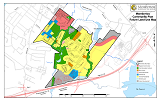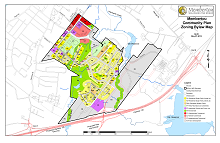MGS Services
Membertou Geomatics Solutions uses a combination of methods to create visual representations of your geographical project area that provide more data than photographs alone. These representations contain layers of detailed information collected from one or more sources. The result is a clear and in-depth view of your project that is as accurate, relevant and up to date as required to be a valuable tool for business decision-making.
Community Planning
Vibrant communities are constantly moving forward. They are always looking for ways to improve, grow, and to build a solid foundation for the future. Our Community Planning Geographic Information Systems (GIS) services can help community leaders gain a clear understanding of their community events and how best to serve their constituents.
There are a multitude of GIS applications that can address economic, environmental and cultural issues. Everything from long-term land development plans and site designs, to delivery of services such as emergency health care and infrastructure repairs can be enhanced with clearer information from GIS sources.
For example, a community focused on sustainable development may be considering the impact of development. Information from GIS can help in all three areas of decision making.


Economic
- Ensure client use of community resources and funds
- Investigate possible income-generating facilities
- Determine the need for resource for the community
Environmental
- Plan for responsible use of available land
- Design for low impact on the environment
- Visualize to ensure aesthetically acceptable options
Cultural
- Determine the demand for a community resource
- Locate and inventory areas of cultural significance
- Choose most accessible location for community gathering point
This is just one example of the many ways GIS services can help communities make informed decisions. Find out how Membertou Geomatics can provide the information you need to help make your community a more insufficient and vibrant place.
Mi'kmaq Traditional Ecological Studies
The Aboriginal community have a long-existing, unique and special relationship with the land and its resources which involves exploitation and conservation as well as spiritual ideologies. This knowledge is held by Aboriginal individuals and has been passed on from generation to generation; kisaku kinutemuatel mijuijij (Mi'kmaq).
Traditional Ecological Knowledge Studies (TEKS) gather and document the collective body of ecological knowledge which is held by the Aboriginal people. These studies may accompany an Environmental Assessment or Impact Statement but can also document the knowledge as a community project.
The TEKS will provide assurances that the Aboriginal use and knowledge of the area in question and its resources are considered within the overall environmental presentation and as well, will further ensure that the Environmental Assessment required is thorough.
A Traditional Ecological Knowledge Study achieves to document and analyze information gathered regarding the special relationship between the people and the land.
A TEKS can help provide a better understanding of an area prior to being developed.
- A Historical Review regarding past occupation and use of the area
- Traditional Land and Resource Use Activities
- A Traditional Significance Species Analysis
At the end of the study, the final delivery is usually a report with a summary of the data collected, along with accompanying maps.
Data Capture, Analysis & Manipulation
Membertou Geomatics Solutions provides a variety of services that can help you collect, analyze and customize data. Data may be spatial, including geographical data and properties, or numerical, such as how many people or buildings are in a certain geographic district.
Through accurate measurements, data analysis, imaging and advanced technology, we can help you turn data into solid decision-making tools.

Some data capture/conversion methods include:
- Photogrammetry
- Database and Lidar
- Database Mapping
- GPS field surveys
- Surveys from hard copy maps
- Database Mapping
Using these technologies, we create and combine images, databases and other packages of information, to help you see the core of the situation, and often, the cause and effect relationships involved in any complex environment. With this clear view, you gain the insight you need to make informed decisions, and develop solid plans of action.
Remote Sensing
One of our key data capturing techniques is remote sensing, which combines elements of imagery, photography and numerical data captured from low to high altitude and space sensors. Common methods of collecting this information are aerial photographs, satellite imagery, and RADAR/LIDAR.
Data from remote sensing has benefits over traditional visual tools such as provincial or municipal maps. Where most existing maps are dictated by old information, remote sensing provides the ability to use current information that is customized to the client project. The maps and other visual aids created from remote sensing are highly accurate, detailed and scalable. With this type of information, remote sensing provides a view of the area in its current situation, with images that are up to date and relevant to your project.


There are many examples of areas where remote sensing can provide efficient imaging solutions, including:
- Digital terrain models
- Spot elevations and hillshade terrain mapping
- Natural resource and feature inventories
- Land use and thematical maps
- Olumetric and area calculations
- Environmental monitoring and management
Remote sensing also allows us to map out whole communities in 3D, transforming 2D images, pixel by pixel, into 3D real-world coordinate system. The result is a clear view of our environment, which may then be used for further imaging, such as 3D visualizations or virtual tours to help you develop a realistic and informed sense of the situation – and the action plan to move ahead.